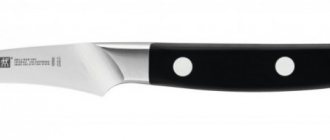Garlic is very good for health, and it is also indispensable in home cooking as a seasoning. The best garlic is the one grown on your own plot.
You can buy good garlic at the market from gardeners immediately after harvesting. But maintaining it until next season is not easy.
Over time, the cloves begin to dry out, oxidize or rot, and insects can infest them. To avoid this, many thrifty people freeze garlic in the freezer.
We will tell you later whether it is possible to freeze garlic for storage and how to do it correctly.
Is it allowed to be stored in the freezer?
Yes, garlic can be frozen. This is a great way to preserve as much as possible the substances it contains that make it aromatic, tasty and healthy. Freezing as one of the most effective methods of canning is used not only by housewives, but also by professional chefs.
The taste and aroma become slightly less pronounced after freezing. But the changes are almost invisible. The richness of garlic aroma and taste can be adjusted by slightly increasing its dosage.
Garlic does not lose its beneficial properties when frozen. If you prepare it correctly, freeze it, defrost it, it remains just as useful.
Its main medicinal functions:
- kills bacteria;
- speeds up metabolism;
- strengthens the immune system;
- prevents thrombosis;
- helps fight intestinal parasites.
Advantages and disadvantages
Housewives often use freezing garlic to store it. This method has both pros and cons. Namely:
pros:
- garlic retains antibacterial properties;
- retains useful microelements;
- lasts longer than any other method;
- ready to use immediately.
Minuses:
- loses a little aroma;
- the taste is not as pronounced as fresh;
- after defrosting, it loses its appearance and “creeps”.
The pros and cons overlap each other, as a result of which each housewife herself will evaluate the advisability of freezing garlic. An alternative could be a method of preserving garlic for the winter, such as drying it for seasoning using household appliances or fresh air.
Freezing methods
You can freeze it in several ways:
- Whole onions.
- Separately cleaned cloves.
- In the form of a paste.
The freezing option is chosen taking into account how the garlic will be used later.
When choosing to freeze onions or cloves, you need to take into account that after defrosting it will become soft and shapeless . No matter how hard you try, you won’t be able to use it as a juicy, crunchy ingredient, for example, in a salad.
Bulbs
Whole unpeeled heads of garlic are rarely frozen, since after defrosting it will be necessary to remove all the scales and partitions that stick to the softened cloves. Choose this method if you have no time to prepare before freezing.
This canning is done as follows:
- cut the stem as close as possible to the head;
- remove the top rough scales, leaving only a thin film;
- wrap each head tightly with cling film;
- place the bulbs wrapped in film in the freezer so that they do not touch each other;
- After a day, you can remove the frozen onions, collect them in a bag for compact storage, and quickly return them to the freezer.
With cloves
The cloves can also be frozen with the husk. But it is much more practical to peel them while they are still fresh, when they are hard and easily released from the shell.
Procedure for this freezing method:
- Clean the cloves thoroughly.
- Remove damaged slices.
- Pack several cloves into bags.
- Load into the freezer.
- Later, the already frozen bags can be collected into one large bag or container.
It is advisable to use bags with an airtight closure. It is better not to wrap it with film - it will be difficult to remove. In each individual bag you should put as many cloves as you usually use when preparing one dish.
There is another way to freeze garlic cloves:
- clean and sort out the slices;
- place them in bulk on a large board;
- After a day, collect and put in a common bag or container.
The second method requires more attention - you need to make sure that the cloves freeze quickly and do not touch on the board. Then, the already frozen slices will not stick together, and you can take as many cloves from the common package each time as you need to prepare a specific dish.
Garlic paste
Garlic can be ground in a blender, turning it into a paste, and then frozen. This method is the most labor-intensive. But it is more convenient to use the paste after defrosting - there is no need to clean and grind it. The paste is packaged in small bags, ice cube trays, or medium-sized packaging bags (distributing the crushed root vegetable in a layer).
Sequencing:
- Grind the peeled and selected garlic with a blender (you can grate it with a grater or pass it through a meat grinder).
- Distribute the paste into bags or molds.
- Place in the freezer.
- After a day, the frozen cubes can be removed from the bags and molds, transferred to one common container, and returned to the freezer (this must be done very quickly).
You can add the same chopped herbs to the chopped garlic mixture before freezing. These ingredients should be mixed in the proportions that you usually use for your dishes.
Features of freezing garlic for the winter
Garlic, if the harvesting rules are followed, does not lose its properties for several months. To do this, it is recommended to select intact heads that have no visible damage. The latter create conditions for the penetration of pathogenic microorganisms, due to which the vegetable will quickly deteriorate or lose its taste.
Before you prepare a product in the freezer, you should decide what will be stored. For freezing use:
- heads, including crushed ones;
- arrows;
- greenery.
The shoots must be cut off at the initial stage of plant growth. During this period, the stems are tender and juicy, and the seeds have not yet appeared in the bud.
Regardless of the type of product chosen, it is recommended to store the latter at a stable temperature of -18 degrees. If the head is defrosted, the greens or arrows should be consumed. If placed in the refrigerator again, the plant will become unedible.
How to defrost?
When adding frozen garlic to hot dishes, defrosting is not required. You just need to take the required number of cloves or crushed mixture out of the freezer and add it during cooking. Under the influence of high temperature, the garlic will quickly thaw, its aroma and taste will instantly reveal. But this only applies to peeled garlic.
If whole onions were frozen, or garlic needs to be added to a cold dish (salad or appetizer), then before use it must be properly defrosted, and the onions must also be thoroughly cleaned.
Defrosting procedure:
- remove from the freezer and place on the refrigerator shelf;
- after a few hours it can be taken out and kept until completely thawed at room temperature;
- Peel the onions;
- chop the cloves;
- season the dish.
The garlic puree will be mixed with liquid after thawing. It can be drained or used for hot dishes.
When frozen, garlic can be stored until the next harvest. Maximum – one year. If it hasn't been used in a year, it's better to throw it away and make fresh supplies .
Thawed garlic, regardless of the freezing method, should be used within a maximum of 4 days. Then it will acquire an unpleasant odor.
Briefly about how to freeze garlic
To freeze garlic after it has been chopped or cloved, peel each piece of garlic you plan to freeze. Then wrap all the garlic in aluminum foil or plastic wrap. Place the wrapped garlic in a resealable freezer bag. Before sealing the bag tightly, release all excess air from it. Label the package with the date. Place the bag in the freezer. Garlic will keep in the freezer for up to 6 months!
Application
Frozen garlic is used like regular fresh garlic. Suitable for preparing any dishes:
- soups;
- salads;
- marinades;
- side dishes;
- pilaf;
- sauces;
- snacks.
In order for the garlic to combine evenly with the rest of the ingredients, it needs to be chopped. In some cases, you can add whole cloves (for example, to pilaf or marinades). But not everyone will like the soft, shapeless pieces in soups and salads.
Since the taste and smell of frozen root vegetables are slightly weaker, you need to add more of them than raw ones. But it’s important not to overdo it here. It is better to add garlic 2-3 grams (the size of an average clove), gradually bringing the dish to the desired taste and smell.
Dried garlic - a classic winter preparation
The dried version of garlic is an excellent opportunity to store large quantities, taking up a minimum amount of space. Dried garlic is practical, healthy and economical.
The technology for drying garlic is very simple - first, the garlic should be divided into cloves, thoroughly peeled and washed. Dry, wipe with napkins. Let's move on to slicing. The thinner the cut, the faster the garlic will dry. It should be cut into slices. Place a piece of parchment paper on a large baking sheet. And only spread the slices of garlic on it in one layer. Preheat the oven and set it to the lowest possible setting. If the oven is too powerful, you can open the lid slightly. Thus, the garlic is dried. On average, this procedure takes 5-6 hours, but it all depends on the thickness of the slices.
When the garlic is dried, you can leave it in this form and send it to a special container for bulk with a lid, or use a mortar to grind it to powder and also transfer it to a container with a lid.
Other options
Alternative options:
- Salting.
- Drying.
- Pickling.
Dried garlic is convenient to store and use. But this is a rather complicated method of preparation. The garlic cloves must first be cut into thin slices and then dried in the oven for several hours. In this case, it may burn or not dry completely.
An option for drying garlic - in the video:
When pickling, garlic is covered with salt, a natural preservative. The salted root vegetable should be packaged in jars with airtight lids . You can pour the root vegetable with a salty solution and store it in a jar on the refrigerator shelf. In any case, containers with pickling take up a lot of space.
You can pickle garlic with the addition of vinegar, sugar, salt and various spices. This way it will retain its crispy texture. But the pickling procedure may be too complicated for those who do not like and do not know how to can their own vegetables.
How to cook spicy pickled garlic - on video:
Tips for freezing garlic
Choose the highest quality organic garlic you can find in the store. The fresher and better quality the garlic, the better it will retain its flavor after freezing. Garlic should be hard - this means it is fresh. Make sure there are no stains, green growth or mold.
After peeling and removing sprouts and stems, dry the garlic thoroughly. The absence of excess moisture helps preserve the fresh, strong flavor of garlic after freezing.
Use freezer safe, airtight containers as directed above. This not only helps maintain fresh taste and reduces the risk of packaging being damaged.
Recommendations
You need to freeze garlic in August or early September, when it is still as fresh and juicy as possible . The longer it sits, the drier it will be, and the more it will lose its taste and aroma.
Garlic can be frozen along with herbs or as a sauce. Packing the preparations into portions for one dish. For example, you can make separate preparations for borscht, pilaf, and marinated meat.
In addition to garlic cloves, you can freeze garlic arrows. They are chopped or ground into a paste. The arrows are frozen separately, along with the cloves, with parsley and dill, or as a ready-made sauce with the addition of spices, butter, and cream.
Instructions
How to freeze garlic for the winter? At what temperature should I freeze?
For freezing any vegetables stored in this way, the ideal temperature is -18 degrees .
It is maintained in the freezer compartment of the refrigerator and in any freezers. At this temperature, garlic will last a long time, will not lose its beneficial properties and will be ready for use immediately after defrosting.
Before freezing garlic in the freezer, you need to follow a number of steps:
- Process garlic : separate unusable cloves, select undamaged ones.
- Peel the garlic cloves.
- Place them in plastic bags if you plan to freeze whole slices.
- Grind in a meat grinder and put the mass into plastic containers if you decide to freeze the garlic in the form of a mass.
- Place bags or containers in the freezer.
It is better to take small containers for freezing the garlic mass and small plastic bags for freezing the cloves. It's extremely practical. Freezing garlic in small portions makes it more convenient to use.
Dry pickling of garlic
In addition to freezing or drying garlic, it can also be salted, since salt will become an excellent preservative, which will successfully preserve the garlic all winter. The average guideline for the amount and ratio of salt and garlic is that for 2 kg of garlic you will need 600 grams of salt. The cooking principle is not complicated. The garlic is peeled, washed and passed through a meat grinder; you can use a blender. Next, salt is added as a preservative - the product is ready. Advice: It is better to use small glass jars with a screw-on lid for storage, for example, for fish spreads on a sandwich. It is inconvenient to close a large jar, since such garlic preparation lasts for a long time.
Salting garlic in water
Alternatively, you can prepare garlic in salt water, which will have an ideal appearance, no different from fresh, and has a wide range of uses. The procurement process is simple. Wash and peel the garlic, leaving the cloves whole. Combine salt with water. For 600 grams of water you need 50 grams of salt. The garlic should be completely covered in the jar with brine. This garlic can be stored in the refrigerator for a long time.











